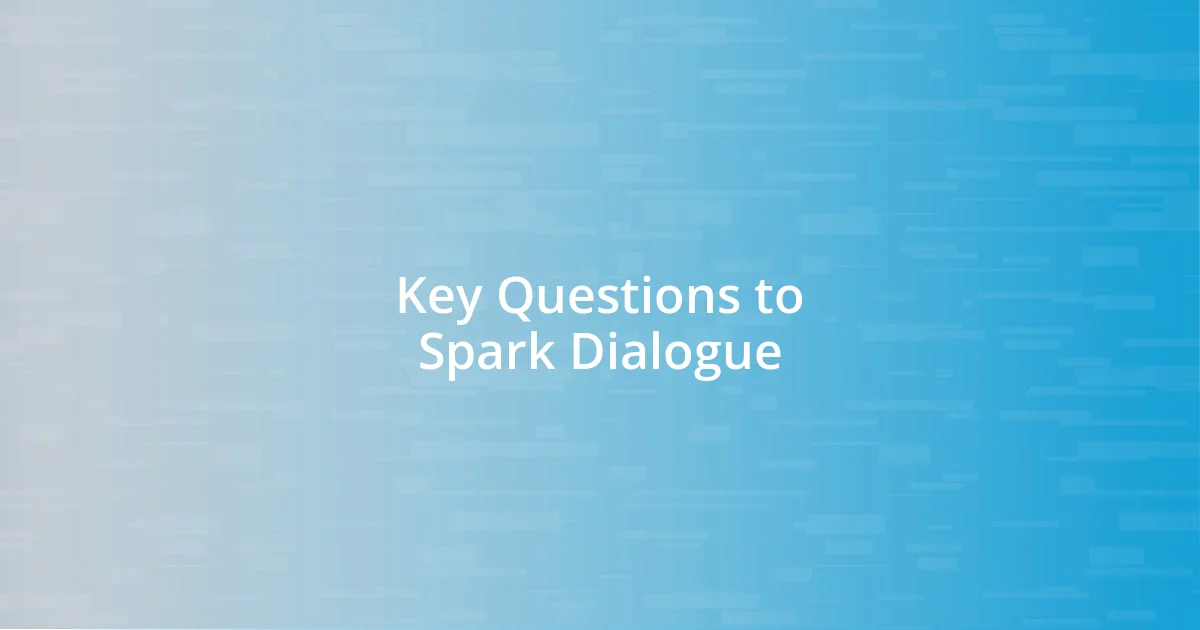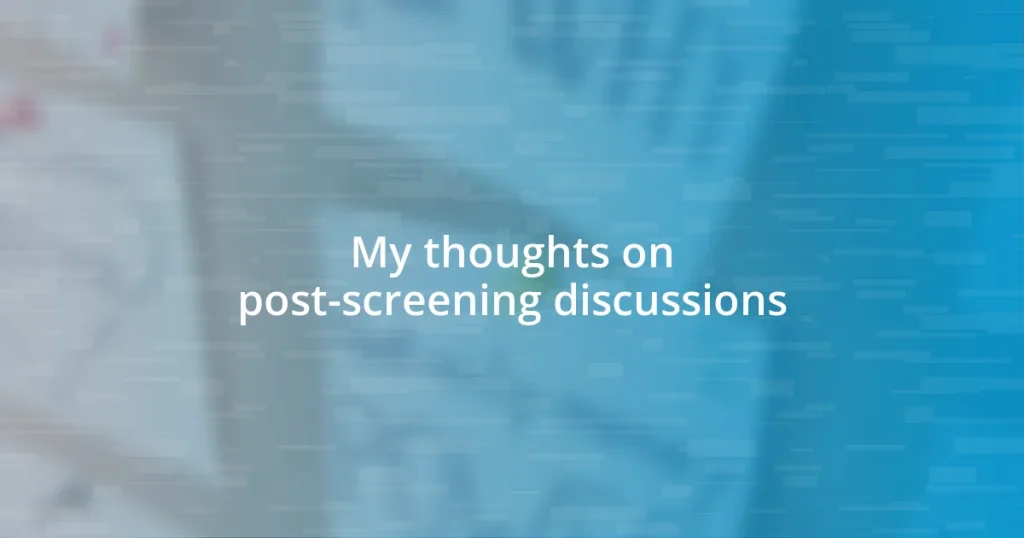Key takeaways:
- Post-screening discussions enhance understanding, foster community, and encourage critical thinking by diving into diverse interpretations of films.
- Engaging conversations improve empathy and motivation for action, often leading to deeper appreciation for the themes and messages presented.
- Effective facilitation techniques and incorporating feedback are essential for enriching discussions and ensuring all voices are heard, promoting a more inclusive dialogue.

Importance of Post-Screening Discussions
Post-screening discussions serve as a vital bridge between viewing a film and understanding its deeper meanings. I remember finishing a thought-provoking documentary and feeling a swirl of emotions, only to find the real epiphanies came when I shared my thoughts with friends afterward. Have you ever noticed how those conversations can illuminate perspectives you hadn’t considered?
These discussions can foster a strong sense of community among viewers. I once attended a screening where diverse opinions sparked a passionate debate, challenging my own beliefs. It was a surreal experience to realize that our interpretations could vary so widely yet still come from a place of shared experience; it made me feel more connected to those around me.
Moreover, engaging in conversations after a screening can promote critical thinking. Reflecting on the narratives presented not only enriches my understanding but allows me to question the societal implications behind them. Isn’t it fascinating how a simple chat can transform a fleeting moment into a lasting learning experience? It often feels like those discussions encourage me to take the themes and apply them to my own life, making the film truly resonate.

Benefits of Engaging Conversations
Engaging conversations after a screening can significantly enhance our appreciation for the film. I recall a time when I watched a visually stunning movie but left feeling perplexed about its themes. During a discussion with friends, I was surprised by their insights that helped me see beauty in subtleties I had missed, igniting a passion for deeper analysis in films. It was a reminder of how dialogues can expand our horizons and reveal hidden layers in what we see.
Another benefit is the way these discussions cultivate empathy. I once shared my thoughts on a film that explored the struggles of a marginalized community. Listening to others’ perspectives opened my eyes to experiences outside my own, helping me understand their stories on a more emotional level. I realized that such exchanges not only challenge our viewpoints but also nurture compassion and understanding.
Lastly, engaging in post-screening discussions can inspire action. I participated in a conversation about a documentary on climate change that stirred a sense of responsibility within me. Those insights compelled me to educate others and engage with local environmental initiatives. Conversations like this often ignite a spark, motivating us to transform our understanding into tangible steps that can contribute to change.
| Benefits | Examples |
|---|---|
| Enhanced Appreciation | Discussing themes and hidden meanings can deepen enjoyment of films. |
| Empathy Growth | Understanding varied perspectives fosters compassion and greater awareness. |
| Motivation to Act | Conversations can lead to taking initiative in social or environmental issues. |

Techniques for Effective Facilitation
Facilitating effective discussions post-screening requires a blend of active listening and creating a welcoming environment. I’ve noticed that when I open the floor for opinions, the atmosphere becomes electric with energy and curiosity. Perhaps it’s because participants feel valued when their thoughts are heard, making them more willing to share. Encouraging everyone to participate, even those who might be shy, can lead to incredibly rich conversations.
To make facilitation engaging, I often utilize the following techniques:
- Open-Ended Questions: I frequently ask questions that prompt deeper reflection, like, “What did this scene evoke for you emotionally?” This invites personal connections to the film.
- Summarize and Reflect: After someone shares, I summarize their points and reflect on them. It shows that I’m listening and fosters a sense of community.
- Encourage Diverse Opinions: I appreciate diverse perspectives and encourage others to voice contrasting views, as these moments often lead to the most enlightening discussions.
- Use Humor: Light jokes or relatable anecdotes can alleviate tension and make participants feel at ease, allowing for more open dialogue.
- Follow-Up Questions: By diving deeper into participants’ responses with follow-up questions, I often uncover unexpected insights that enrich the conversation.
I’ve found that employing these techniques not only elevates the discussion but also creates memorable experiences. For instance, after a particularly intense film, using humor softened the mood and encouraged even the quietest members to share. Those unexpected turns can catalyze surprising revelations, lighting a spark in everyone involved.

Key Questions to Spark Dialogue
To spark meaningful dialogue, I often find myself starting with the question, “What moment in this film surprised you the most?” It’s fascinating how this simple prompt unlocks a variety of emotional responses. I remember watching a thriller where the twist caught everyone off guard. Hearing friends recount their surprise made me appreciate the film’s clever storytelling in a new light.
Another powerful question I love to pose is, “How does this character’s journey resonate with you?” Reflecting on personal connections can spur deeper conversations. I once asked this after a film centered on resilience, and it led to an intimate sharing of experiences. I believe when people relate personally, the dialogue becomes richer and more heartfelt, allowing for an exploration of shared human experiences.
Lastly, I’ve experimented with asking, “What themes do you think the filmmaker was trying to convey?” This question not only stimulates analysis but encourages participants to engage critically. In one discussion, someone interpreted a film’s portrayal of loneliness in a way that shifted my entire perspective. It’s moments like these that remind me how powerful our collective insights can be, turning a simple post-film chat into a profound exploration of human emotion and storytelling.

Handling Differing Opinions Respectfully
When it comes to handling differing opinions, I believe the key lies in fostering an atmosphere of respect and openness. I’ve been in discussions where strong disagreements arise, and I’ve learned the importance of pausing to acknowledge each perspective. For instance, during one screening, a friend passionately disagreed with my take on a character’s motivations. Instead of pushing back, I asked her to elaborate, which not only deepened my understanding but also demonstrated respect for her viewpoint.
I often find that tone plays a crucial role in these exchanges. Using phrases like “That’s an interesting perspective; can you tell me more?” can diffuse potential tension and invite further dialogue. I remember a time when someone shared a controversial opinion about a film I adored. Rather than feeling defensive, I allowed curiosity to guide me. My willingness to explore her thoughts led to a richer conversation, and it was rewarding to uncover aspects of the film that I hadn’t considered before.
Empathy is another vital component in these discussions. I’ve found that acknowledging how a film might resonate differently with various backgrounds can create a bridge for understanding. For example, while debating a film that highlighted systemic injustice, I asked others how their experiences influenced their views. One participant shared a personal story that not only colored their interpretation of the film but also reminded me of the importance of our individual narratives. It’s moments like these that reveal the beauty of respectful discourse amidst differing opinions.

Incorporating Feedback for Improvement
Incorporating feedback is essential for enhancing the quality of discussions. I remember after one screening, I asked a group for their thoughts on how I facilitated the conversation. Their honest feedback included suggestions about being more open to quiet participants. This not only helped improve my future discussions but also emphasized the importance of creating space for all voices.
One particular piece of advice that stuck with me was to encourage quieter members to share their thoughts early in the conversation. After implementing this in a later discussion, I noticed a quieter friend shine as they shared insights I’d never anticipated. It made me realize that feedback is not just about critiquing but also about discovering hidden gems of wisdom from fellow viewers.
Asking for specific feedback can shape your approach significantly. I often find myself pondering questions like, “Did I guide the conversation effectively?” or “Did I create an inclusive atmosphere?” Engaging the group in a post-discussion feedback session not only fosters improvement but also builds a sense of community. I’ve seen the magic happen when everyone feels their input is valued; the depth of conversation truly flourishes.
















